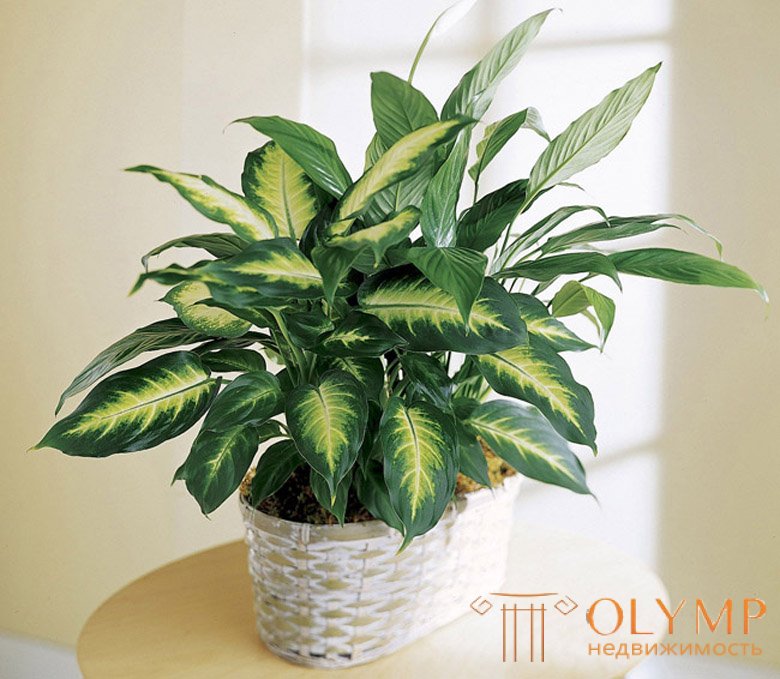
Dieffenbachia is an ornamental evergreen with large leaves alternately arranged on the stems. Since the plant originates from the humid tropics, it needs similar conditions in culture: constantly high temperatures and air humidity. Despite the capricious nature, it is very often (it has been cultivated for 150 years now) used for gardening interiors.
Dieffenbachia grows quickly and reaches 2 m. Do not forget that the plant is poisonous! If juice enters the mucous membranes and skin, irritation and swelling may begin. Therefore, it should be placed only in those places that are inaccessible to children and animals. They work with her in gloves. After work do not forget to wash your hands with soap. 
Kinds
Systematics Dieffenbachy extremely confused, experts rarely agree on the name of the species. The only kind with green leaf color that you may meet is D.oerstedii; it can be identified by a well-pronounced white midrib. The most common species is D.picta (D. maculata) with ovoid leaves in ivory-colored specks. The specks have a different shape or merge into a large spot on Exotika variety plants — in the Camilla, Marianne and Rudolph Roehrs varieties, the leaf is almost entirely cream or ivory. If you prefer a larger plant, you can opt for D. amoena in which the leaves reach a length of 50 cm, and the stem is 1.6 m in height. On dark green leaves - white stripes, most clearly expressed in the variety Tropic Snow. Yellow-green D. bausei and D. bowmannii (D. Baumann), which has gigantic (up to 70 cm and more) leaves, look unusual.
Diefenbachia care is common to all aroids. The only difference is that it does not tolerate lime, so the water for irrigation and spraying should be well separated and always warm (not lower than room temperature).
Lighting - from bright to dim, unacceptable direct sunlight. It can even be placed in the depth of the room with additional artificial light. In the summer you can take out to the open air. In addition to spraying, it is recommended to wipe the leaves with a soft damp cloth.
In the spring and summer, every ten days, and in the fall and winter, once a month, the plant is fed with organic or non-lime mineral fertilizers. Please note that the form dieffenbachy with white leaves with insufficient lighting and a large amount of nitrogen in the soil is green. Therefore, it is better not to use organic fertilizers for such plants at all, and to reduce the dose of mineral fertilizers by half.
The plant is propagated by apical stem cuttings that are rooted in water, in sphagnum, sand, or a mixture of sand and peat (1: 1). In order for the cuttings to root faster and better, the following conditions must be observed: often spray and wipe the leaves, protect them from direct sunlight, maintain the substrate temperature not lower than 21-23 ° C and cover with glass or plastic wrap. If you have rooted the stalk in the water and the roots have reached a length of 2-3 cm, then they can already be planted in pots. And if rooting occurs in moss or sand, it is good to feed the cuttings with a weak solution of mineral fertilizer (1/4 of the prescribed dose). And when the roots grow well, they are transferred to the pots together with a lump of substrate.
Dieffenbachia can be propagated and stem pieces. Cut it into cuttings 15–20 cm long (3-4 internodes), be sure to sprinkle the cuts with sulfur or charcoal and dry for 1-2 days. After that, lay the cuttings horizontally and press them to the substrate so that they are 1 / 3-1 / 2 of the thickness turned out to be covered with soil. Rooting and the formation of shoots is very slow (up to 6-10 months). Make sure that the cuttings do not rot, and the substrate is slightly wet. After waking up the buds and starting to unfold the leaves, you can pour fresh ground to the base of the shoot, and when the plants are strong, transplant them, deepening a piece of old stem into the soil (in no case separate it).
After you have cut the cuttings or removed the bare shoots, the remaining stump can start growing again: new shoots with leaves will appear from the nodes. When 2-3 new leaves grow, the stem is cut and planted in a light substrate. So you can get another instance of a rather expensive plant.
Transplanted in the spring, if necessary, into a mixture of leaf earth, humus, peat and sand (3: 1: 1: 1). A new pot should be slightly larger than the previous one. Stalk when transplanting is desirable to slightly deepen. Then additional roots will grow from its submerged part.
It grows well in hydroponics.
It is damaged by the shield, spider mites, aphids and thrips ..
Что бы оставить комментарий войдите
Комментарии (0)